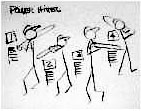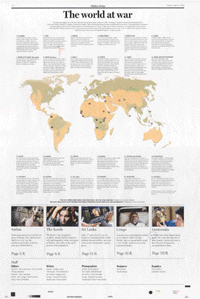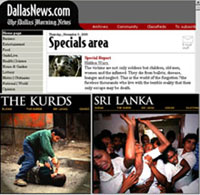A long time ago, in a land not too far away, a child was first learning the art of writing. As many have done before him, he drifted from the assignment and began to turn the letterforms into different shapes-shapes that were fueled by his inherent drawing skills.
Suddenly, the student received a sharp rap across the knuckles and heard a harsh voice say, "That's not the way we do it, stick to the proper method and stop that infernal doodling."
And so, another young mind was influenced to abandon a natural instinct to think visually and developed instead, a fear of drawing.
That fear eventually took the form of a visual impediment, an impediment not only for the few but also for the many. So that today, we have a population of communicators who have adequate, sometimes wonderful speaking and writing skills but who are literally tongue-tied when faced with the need to communicate visually.
Visual Storytelling
The need for a visual language is increasing daily. Readers are demanding a different type of news-not different in its basic tenants of truth and fairness but different in its presentation. It simply is not enough to place the information before the reader. The volume and types of information being gathered and reported now require structure and visual consideration.
 Not great art, but the concept is clear. |
It begins with the reporter-recognizing the visual opportunity of an event and then being willing to actually draw a concept for how the information might lend itself to visual storytelling.
At this stage, it's important to understand that we are not talking about creating fine art. What we need is a visual concept-a primitive rendering of the reporter's thinking. This is probably the most difficult step in the visual reporting process. We are changing a condition that has been in place for years.
Communication is all about storytelling. The best storytellers are using a visual language that supports and enhances the world of words. They have discovered that not only can visual storytelling be more informative by simplifying complex information but that it can attract a wider audience. The natural companion to the visual is presentation, so that the results are dynamic, interesting images, paired with good writing and designed to reflect the added value of the content. It's win, win, and win for the reader.
So, how do we get there? How do we alter behavior and modify our thinking to include a visual component?
A proven modifier of behavior is reward.
Take an idea, any idea and think of it in purely visual terms.
Keep it simple. Give someone directions to your home. Don't write them down. Draw a map.
Warn your child of a danger. Don't write it out. Create a symbol to illustrate danger. When telling the story of how a soccer player executes a particular move, draw simple stick figures to explain the concept.
When selling a story idea to an editor, draw the concept out so that then editor can actually see your thinking.
When your friend arrives on time, your child understands the threat, the reader has new knowledge and your story idea is sold, then you have your reward.
The next time you visit the local supermarket, take a moment to look at the display of magazine and newspapers that are for sale. Notice the high level of visual energy that is being used to get your attention.
It's a competition. All of these products are selling information and you, the buyer are being prompted by a barrage of words, color, illustration and photography to make a selection.
Think Visually
The same is true for broadcast and the Web-probably to an even greater degree.
 Visual component plays an important role in journalism. |
There was a time when the information alone was sufficient to guarantee readership. Those days are gone. Good writing and reporting is certainly valued but can easily be lost in the mass of information that is dumped upon us each day. Designing that daily dump with an eye towards its visual value can help to draw readers to good reporting. It's a proven fact that when a visual accompanies a story, readers are more likely to be attracted to that content.
To reacquire the power of visual thinking, go back to that time when your mind was free of clutter and open to creativity and innovation.
Say, around the age of three or so. Express yourself, with no concern about negative remarks or projected rejection. Enjoy the freedom of contacting pencil to paper as you draw out ideas with no care as to their realism. Simply draw. Now take your collection of images and begin to see how they pair with content. Maybe string together unrelated images to complete an idea. It's similar to writing-gathering together all of your notes to create a whole.
Like any skill, it will take time to develop confidence and form the habit to do it automatically. But if you practice thinking visually more images will present themselves to you in the way of a budding vocabulary-shapes, colors, textures and more. Plus, you will begin to see visual opportunities where you hadn't before, making you a better and more complete storyteller.
Another advantage of visual storytelling is that it has the ability to draw readers into content they may find intimidating.
Business stories can be filled with figures and acronyms that are foreign to the casual or fringe business reader. But translate those numbers and letters into an explanatory graphic and it's as if you have broken a code and revealed secret information to those on the outside looking in. Breakdown the stock tables into a "how to use" graphic and you've advanced information to a new audience.
The same is true of sports. Explain a big play or translate statistics into a visual and you have more folks gathered around the water cooler on Monday morning impressing everyone with their knowledge of the game.
Presentation Value
We are a knowledge-based society. What that seems to mean is that while knowledge may not be wisdom, it certainly means power.
 Internet provides new presentation on the Web. |
Print, broadcast and the Web are the information providers. It's the responsibility of these providers to provide essential information in a form that is accessible and accurate. We have the accuracy pretty much under control. But we are in the early stages of understanding the presentation value of the content.
To continue the tradition of excellence that print and broadcast have built, traditions are being broken to expand existing journalism curriculum to include a visual component. The Web is so new, that it is writing its own history and learning quickly from success and failure.
It all comes down to changing the way we think about the information. In many ways the news repeats itself but continuing to repeat how we offer the news will only serve to inflict a terminal cancer upon the traditional information providers.
Think and report visually. Make good writing accessible. Entertain and inform. Be essential. And most important...doodle.


